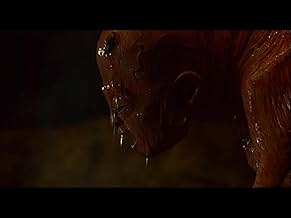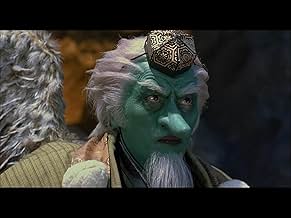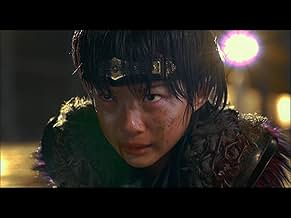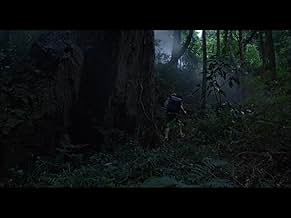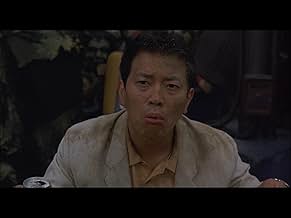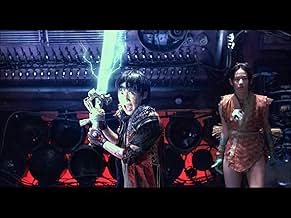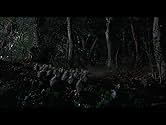NOTE IMDb
6,3/10
2,8 k
MA NOTE
Ajouter une intrigue dans votre langueA young boy is chosen as the defender of good and must team up with Japan's ancient spirits and creatures of lore to attempt to destroy the forces of evil.A young boy is chosen as the defender of good and must team up with Japan's ancient spirits and creatures of lore to attempt to destroy the forces of evil.A young boy is chosen as the defender of good and must team up with Japan's ancient spirits and creatures of lore to attempt to destroy the forces of evil.
- Réalisation
- Scénario
- Casting principal
- Récompenses
- 3 victoires et 1 nomination au total
Ryûnosuke Kamiki
- Tadashi Ino
- (as Ryuunosuke Kamiki)
Seiko Iwaidô
- Kawahime, the River Princess
- (as Mai Takahashi)
Avis à la une
This film is a bit reminiscent of the German film, THE NEVERENDING STORY because a child is magically transported to a strange land in order to be a hero. However, due to far superior modern technology, puppets and CGI are used to make an amazingly realistic looking world--one that will blow your socks off due to its realism and scope.
I enjoyed this film, but boy was it a chore at first! Unfortunately, for most Westerners, this film is one you might give up on very quickly or dismiss it since everything in the film seems so odd. However, give it a chance. Don't think or try to understand everything you see--just allow the story to unfold and you will most likely enjoy the film.
In many ways, this is exactly the sort of advice I'd give to adults who watch Miyazaki's SPIRITED AWAY because it is very similar and features tons of Yokai (Japanese mythical spirits). The big differences between the two is that THE GREAT YOKAI WAR is live-action and SPIRITED AWAY is much more child-friendly. While I do think THE GREAT YOKAI WAR was intended mostly as a kids' movie, in the USA, most parents would not want to show this to younger kids because it's so violent, scary and features some adult behaviors. So who is the audience in the West? Well, older kids and adults who appreciate foreign films with non-Western themes and composition. This is a rather narrow audience, indeed!
While you are watching, look for all the strange little touches. In fact, you could watch the film dozens of times and notice different tiny things each time. A few of the funny references I liked were the comment about Gamera, the scene that came with the comment "KIDS: Don't Try This At Home" as well as the use of Kirin beer to allow a person to actually see the Yokai (hmm,...perhaps that scene should have also contained this warning)!
By the way, director Takashi Miike is a hard one to pin down stylistically, other than to say that none of his stories I've seen have seemed "normal". Some of his films are rather disgusting and disturbing and I hated them (especially AUDITION and ICHI THE KILLER)whereas some of them are magical and among the best films I've ever seen (THE HAPPINESS OF THE KATAKURIS). One thing for sure, it's hard to watch one of his films and not have a strong reaction one way or the other.
I enjoyed this film, but boy was it a chore at first! Unfortunately, for most Westerners, this film is one you might give up on very quickly or dismiss it since everything in the film seems so odd. However, give it a chance. Don't think or try to understand everything you see--just allow the story to unfold and you will most likely enjoy the film.
In many ways, this is exactly the sort of advice I'd give to adults who watch Miyazaki's SPIRITED AWAY because it is very similar and features tons of Yokai (Japanese mythical spirits). The big differences between the two is that THE GREAT YOKAI WAR is live-action and SPIRITED AWAY is much more child-friendly. While I do think THE GREAT YOKAI WAR was intended mostly as a kids' movie, in the USA, most parents would not want to show this to younger kids because it's so violent, scary and features some adult behaviors. So who is the audience in the West? Well, older kids and adults who appreciate foreign films with non-Western themes and composition. This is a rather narrow audience, indeed!
While you are watching, look for all the strange little touches. In fact, you could watch the film dozens of times and notice different tiny things each time. A few of the funny references I liked were the comment about Gamera, the scene that came with the comment "KIDS: Don't Try This At Home" as well as the use of Kirin beer to allow a person to actually see the Yokai (hmm,...perhaps that scene should have also contained this warning)!
By the way, director Takashi Miike is a hard one to pin down stylistically, other than to say that none of his stories I've seen have seemed "normal". Some of his films are rather disgusting and disturbing and I hated them (especially AUDITION and ICHI THE KILLER)whereas some of them are magical and among the best films I've ever seen (THE HAPPINESS OF THE KATAKURIS). One thing for sure, it's hard to watch one of his films and not have a strong reaction one way or the other.
Miike makes a children's adventure film, not unlike The Neverending Story. It's actually one of my least favorite of the director's films. Even the worst Miike is better than a good many films, though, and The Great Yokai War has a lot in it that's worth recommending. It's at least as loud and obnoxious as most American kiddie flicks. I might think kids themselves would find a lot to like in it (the DVD includes an English dub), but, like all of Miike's films, it can tend to move very slowly. That means you've got kind of a weird unevenness, where sometimes there's a loud action sequence and the next scene will drag on forever as characters converse. The story itself isn't very good, either, and Miike's perpetual flaw of incoherency rears its ugly head. Most of what I liked came from the technical side of things. This has to be Miike's most expensive movie, and it looks fantastic. "Yokai" are Japanese spirits, and they come in all different, fantastical forms, and the costume designers, special effects crew, and everyone else involved in the designs just did an outstanding job. I've seen the 1968 film this one is supposedly based on (Yokai Monsters: Spook Warfare), and the cheesy rubber-suit monsters you can find there have been transformed into more believable entities using state-of-the-art makeup and special effects. I especially liked the look of one of the bad guys (or girls, in this case), Agi, who sports dark eye shadow, a tight, white outfit, a white beehive hairdo and a whip. She's played, incidentally, by Chiaki Kuriyama, whom you might remember as Lucy Liu's teenage henchgirl in Kill Bill: Vol. 1. The hero of the film is played by Ryunosuke Kamiki, who provided voices for Miyazaki's Spirited Away and Howl's Moving Castle.
What happens when director Takashi Miike (Audition, Ichi the Killer) tackles a children's fantasy film? Unfortunately, the end result is not as awesome as one might expect. The Great Yokai War is a reinterpretation of the Japanese monster classic Spook Warfare (1968) and, like its predecessor, features a host of creepy, and sometimes just plain goofy (I'm looking at you, umbrella monster), creatures from Japanese folklore. Ryunosuke Kamiki stars as the young hero Tadashi who squares off against the evil Lord Kato (Etsushi Toyokawa) and his twisted, but incredibly hot, henchwoman Agi, played by Chiaki Kuriyama (EXTE, Kill Bill: Vol. 1).
Tadashi, the son of recent divorcées, moves from Tokyo to a seaside village to live with his mother and grandfather. In typical children's fantasy fashion, Tadashi lacks confidence. He finds it difficult to adapt to his new life and his heavy-drinking mother and dementia-suffering grandfather don't make it any easier. Everything changes when Tadashi is chosen by the Yokai to be the Kirin Rider, protector of all things good, at a local festival. He discovers that, as the Kirin Rider, he is destined to obtain the magic sword, Daitenguken, from the Great Tengu and protect the Yokai from the advances of Lord Kato and Agi.
Meanwhile, we discover that Lord Kato has summoned Yomotsumono, a massive factory-like Yokai born from all the things that humans throw away. Lord Kato and Agi have also imprisoned several Yokai, including Tadashi's friend Sunekosuri, a cute hamster-like thing with a penchant for humping shins, and developed a method of absorbing their powers and, in the process, transforming them into rage-driven mechanized guardians. Accompanied by a small group of companions, Tadashi undertakes the quest to defeat Lord Kato and rescue Sunekosuri (and Tokyo) before it's too late.
Although this sounds like a great premise for a children's film, in Japan at least, The Great Yokai War never quite reaches its full potential. I expected a bit more experimentation from Miike, especially given the weirdness of the source material. That's not to say that there aren't some great moments: an early scene in which a dying newborn Yokai warns a frightened witness of the coming war is both visually striking and establishes the rather dark nature of the film. Unfortunately, this destined war never quite materializes and, by the end of the film, things just start to seem goofy.
Thematically, Miike tackles the human potential to discard things without a second thought and the detachment from the realm of nature and imagination that inevitably occurs as we grow older. All in all, this is a message that is more likely to resonate with adult viewers than with children, upon whom a lot of the underlying thematic subtleties of the film are probably lost. Adult viewers will find themselves wishing that Miike had explored this rather depressing subject matter as an adult fairytale, something more along the lines of Guillermo Del Toro's excellent Pan's Labyrinth, than within the constraints of a children's fantasy film.
As it stands, The Great Yokai War has its moments and does boast great special effects and a horde of unique and interesting monsters. Unfortunately, it never quite succeeds as either a children's fantasy film or a Miike film. It never really establishes a sense of epicness in regard to Tadashi's quest, an element that is of utmost importance in this type of film. However, genre-wise it is much more akin to the mildly disturbing children's fantasy films of the '80s, like The Neverending Story, The Dark Crystal, and Return to Oz, than to other Miike works, like Audition, Visitor Q, and Ichi the Killer. Fans of the former will probably find a lot to like in The Great Yokai War, while fans of the latter will more than likely be a little disappointed.
Gore Police (dreadfulreviews.com)
Tadashi, the son of recent divorcées, moves from Tokyo to a seaside village to live with his mother and grandfather. In typical children's fantasy fashion, Tadashi lacks confidence. He finds it difficult to adapt to his new life and his heavy-drinking mother and dementia-suffering grandfather don't make it any easier. Everything changes when Tadashi is chosen by the Yokai to be the Kirin Rider, protector of all things good, at a local festival. He discovers that, as the Kirin Rider, he is destined to obtain the magic sword, Daitenguken, from the Great Tengu and protect the Yokai from the advances of Lord Kato and Agi.
Meanwhile, we discover that Lord Kato has summoned Yomotsumono, a massive factory-like Yokai born from all the things that humans throw away. Lord Kato and Agi have also imprisoned several Yokai, including Tadashi's friend Sunekosuri, a cute hamster-like thing with a penchant for humping shins, and developed a method of absorbing their powers and, in the process, transforming them into rage-driven mechanized guardians. Accompanied by a small group of companions, Tadashi undertakes the quest to defeat Lord Kato and rescue Sunekosuri (and Tokyo) before it's too late.
Although this sounds like a great premise for a children's film, in Japan at least, The Great Yokai War never quite reaches its full potential. I expected a bit more experimentation from Miike, especially given the weirdness of the source material. That's not to say that there aren't some great moments: an early scene in which a dying newborn Yokai warns a frightened witness of the coming war is both visually striking and establishes the rather dark nature of the film. Unfortunately, this destined war never quite materializes and, by the end of the film, things just start to seem goofy.
Thematically, Miike tackles the human potential to discard things without a second thought and the detachment from the realm of nature and imagination that inevitably occurs as we grow older. All in all, this is a message that is more likely to resonate with adult viewers than with children, upon whom a lot of the underlying thematic subtleties of the film are probably lost. Adult viewers will find themselves wishing that Miike had explored this rather depressing subject matter as an adult fairytale, something more along the lines of Guillermo Del Toro's excellent Pan's Labyrinth, than within the constraints of a children's fantasy film.
As it stands, The Great Yokai War has its moments and does boast great special effects and a horde of unique and interesting monsters. Unfortunately, it never quite succeeds as either a children's fantasy film or a Miike film. It never really establishes a sense of epicness in regard to Tadashi's quest, an element that is of utmost importance in this type of film. However, genre-wise it is much more akin to the mildly disturbing children's fantasy films of the '80s, like The Neverending Story, The Dark Crystal, and Return to Oz, than to other Miike works, like Audition, Visitor Q, and Ichi the Killer. Fans of the former will probably find a lot to like in The Great Yokai War, while fans of the latter will more than likely be a little disappointed.
Gore Police (dreadfulreviews.com)
Watching The Great Yokai War really felt like going back to childhood. To that youthful time watching movies on a Saturday afternoon that were a little fanciful and that I, at 9 or 10, couldn't quite follow but still enjoyed.
The movie is utterly bizarre, as a young boy is chosen to battle against a great evil with the help of Yokai, which are fantastical folkloric Japanese creatures.
The story is fast paced, doesn't always make sense, is very weird, and is sometimes pretty violent and disturbing for a kid's movie.
It's hard for me to judge the visual quality of this movie because I found a low-rez version on youtube. All I can say for sure is the creatures themselves are tremendously entertaining.
I watched this movie because I'm ever in the search for something weird and not too dark from director Miike, who make The Happiness of the Katakuris but mainly makes movie that sound so dark I can't bring myself to watch them. Yokai War isn't as good as Katakuris, but it is entertaining.
The movie is utterly bizarre, as a young boy is chosen to battle against a great evil with the help of Yokai, which are fantastical folkloric Japanese creatures.
The story is fast paced, doesn't always make sense, is very weird, and is sometimes pretty violent and disturbing for a kid's movie.
It's hard for me to judge the visual quality of this movie because I found a low-rez version on youtube. All I can say for sure is the creatures themselves are tremendously entertaining.
I watched this movie because I'm ever in the search for something weird and not too dark from director Miike, who make The Happiness of the Katakuris but mainly makes movie that sound so dark I can't bring myself to watch them. Yokai War isn't as good as Katakuris, but it is entertaining.
Where was this film when I was a kid? After his parents split up Tadashi moves with his mom to live his his grandfather. Tadashi's sister stays with their dad and they talk frequently on the phone. Grandfather is only "here" every third day. Moms never really home. The kids always are picking on the poor kid. During a village festival Tadashi is chosen the "kirin rider" or spiritual champion of the peace and justice. Little does he suspect that soon he will have to actually step into role of hero as the forces of darkness join up with the rage of things discarded in a plot to destroy mankind and the spiritual world.
Okay that was the easy part. Now comes the hard part, trying to explain the film.
This is a great kids film. No this is a great film,flawed, (very flawed?) but a great film none the less. It unfolds like all of those great books you loved as a kid and is just as dense at times as Tadashi struggles to find the strength to become a hero. Watching it I felt I was reading a great book, and thought how huge this would have been if it was a book. I loved that the film does not follow a normal path. Things often happen out of happenstance or through miscommunication, one character gets sucked into events simply because his foot falls asleep. There are twists and turns and moments that seem like non sequiters and are all the more charming for it (which is typical Miike) Certainly its a Takashi Miike film. That Japanese master of film is clearly in charge of a film that often touching, scary and funny all at the same time. No one except Miike seems to understand that you can have many emotions at the same time, or that you can suddenly have twists as things get dark one second and then funny the next. I admire the fact that Miike has made a film that is bleak and hopeful, that doesn't shy away from being scary, I mean really scary, especially for kids. This is the same dark territory that should be in the Harry Potter movies but rarely is. This a dark Grimms tale with humor. My first reaction upon seeing the opening image was that I couldn't believe anyone would begin a kids film with a picture of the end of the world, then I realized who was making the movie. Hats off to Miike for making a movie that knows kids can handle the frightening images.
Its also operating on more than one level. The mechanical monsters that the bad guys make are forged from mankind's discarded junk. Its the rage of being thrown away that fuels the monsters.One of the Yokai (spirits) talks about the rage sneakers thrown away because they are dirty or too small feels when they are tossed. You also have one of the good guys refusing to join the bad guys because that would be the human thing to do. Its a wild concept, but like other things floating around its what lifts this movie to another level. (there are a good many riffs and references to other movies,TV shows and novels that make me wonder who this film is for since kids may not understand them, though many parents will) And of course there are the monsters. They run the gamut from cheesy to spectacular with stops everywhere in between. Frankly you have to forgive the unevenness of their creation simply because they are has to be hundreds if not thousands of monsters on screen. Its way cool and it works. One of the main characters is a Yokai which I think is best described as a hamster in a tunic and is often played by a stuffed animal, it looks dumb and yet you will be cheering the little bugger and loving every moment he rides on Tadashi's head. (Acceptance is also easier if you've ever seen the old woodcuts of the weird Japanese monsters) I mentioned flaws, and there are a few. The effects are uneven, some of the sudden turns are a bit odd (even if understandable) and a few other minor things which are fading now some two hours after watching the film.. None of them truly hurt the film over all, however most kind of keep you from being completely happy with the movie.
I really loved this movie. I'm pretty sure that if I saw this as a kid it would have been my favorite film of all time. (where's the English dub?).See this movie. Its a great trip. (Besides its a good introduction to the films of Miike minus the blood and graphic sex)
Okay that was the easy part. Now comes the hard part, trying to explain the film.
This is a great kids film. No this is a great film,flawed, (very flawed?) but a great film none the less. It unfolds like all of those great books you loved as a kid and is just as dense at times as Tadashi struggles to find the strength to become a hero. Watching it I felt I was reading a great book, and thought how huge this would have been if it was a book. I loved that the film does not follow a normal path. Things often happen out of happenstance or through miscommunication, one character gets sucked into events simply because his foot falls asleep. There are twists and turns and moments that seem like non sequiters and are all the more charming for it (which is typical Miike) Certainly its a Takashi Miike film. That Japanese master of film is clearly in charge of a film that often touching, scary and funny all at the same time. No one except Miike seems to understand that you can have many emotions at the same time, or that you can suddenly have twists as things get dark one second and then funny the next. I admire the fact that Miike has made a film that is bleak and hopeful, that doesn't shy away from being scary, I mean really scary, especially for kids. This is the same dark territory that should be in the Harry Potter movies but rarely is. This a dark Grimms tale with humor. My first reaction upon seeing the opening image was that I couldn't believe anyone would begin a kids film with a picture of the end of the world, then I realized who was making the movie. Hats off to Miike for making a movie that knows kids can handle the frightening images.
Its also operating on more than one level. The mechanical monsters that the bad guys make are forged from mankind's discarded junk. Its the rage of being thrown away that fuels the monsters.One of the Yokai (spirits) talks about the rage sneakers thrown away because they are dirty or too small feels when they are tossed. You also have one of the good guys refusing to join the bad guys because that would be the human thing to do. Its a wild concept, but like other things floating around its what lifts this movie to another level. (there are a good many riffs and references to other movies,TV shows and novels that make me wonder who this film is for since kids may not understand them, though many parents will) And of course there are the monsters. They run the gamut from cheesy to spectacular with stops everywhere in between. Frankly you have to forgive the unevenness of their creation simply because they are has to be hundreds if not thousands of monsters on screen. Its way cool and it works. One of the main characters is a Yokai which I think is best described as a hamster in a tunic and is often played by a stuffed animal, it looks dumb and yet you will be cheering the little bugger and loving every moment he rides on Tadashi's head. (Acceptance is also easier if you've ever seen the old woodcuts of the weird Japanese monsters) I mentioned flaws, and there are a few. The effects are uneven, some of the sudden turns are a bit odd (even if understandable) and a few other minor things which are fading now some two hours after watching the film.. None of them truly hurt the film over all, however most kind of keep you from being completely happy with the movie.
I really loved this movie. I'm pretty sure that if I saw this as a kid it would have been my favorite film of all time. (where's the English dub?).See this movie. Its a great trip. (Besides its a good introduction to the films of Miike minus the blood and graphic sex)
Le saviez-vous
- AnecdotesThe film contains several direct references and homages to the work of Shigeru Mizuki, the manga artist who is generally credited with bringing the tradition of yokai tales into the modern day via the comic-book medium. The young hero researches yokai by traveling to Mizuki's birthplace of Sakaiminato and visiting the museum dedicated to his work there; the actual museum, and its bronze statues of his most famous characters, including GeGeGe no Kitaro, are shown in the film. Later in the plot, when the yokai Ittan Momen shows reluctance to fight, another scolds it by saying "You're always really brave in those comics with Kitaro!"
- Citations
Kawahime, the River Princess: People live in ignorance. Constantly turning a blind eye. Those that let go of their past, have no future.
- ConnexionsFeatured in Horror's Greatest: Giant Monsters (2024)
Meilleurs choix
Connectez-vous pour évaluer et suivre la liste de favoris afin de recevoir des recommandations personnalisées
Détails
Box-office
- Budget
- 1 300 000 000 JPY (estimé)
- Montant brut mondial
- 15 787 492 $US
- Durée
- 2h 4min(124 min)
- Couleur
- Mixage
- Rapport de forme
- 1.85 : 1
Contribuer à cette page
Suggérer une modification ou ajouter du contenu manquant

